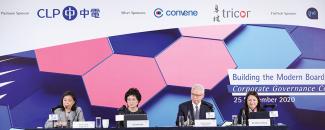
Board building – Corporate Governance Conference 2020 review – part one
The Hong Kong Institute of Chartered Secretaries’ 12th biennial Corporate Governance Conference, held in hybrid mode on 25 and 26 September 2020, addressed one of the toughest and most critically important concerns for governance professionals – how to build and maintain an effective board.
The Hong Kong Institute of Chartered Secretaries (the Institute) has been holding its biennial Corporate Governance Conferences (CGCs) for over two decades and, learning from its experience over the years, has been able to craft a very successful formula for these events. This year’s CGC, however, brought in a new element to that formula in response to the COVID-19 pandemic – the adoption of a hybrid mode. Attendees joined the forum online while most of the speakers and panellists were present at the conference venue.
In her welcoming address, Institute President Gillian Meller FCIS FCS, pointed out that having the speakers and panellists gathered around the same table helps to facilitate those unscripted, impromptu exchanges which are the lifeblood of the Institute’s CGCs, while the webinar format for attendees widens access to the forum.
She also set the scene for the day’s discussions with an overview of the conference theme: Building the Modern Board: A 20/20 Vision. ‘This year’s CGC is a return to one of the core concerns for our profession – how to build and sustain a board which reflects and promotes excellence in governance, is aware of and takes into account the expectations of stakeholders, maximises its own effectiveness, manages risk and pursues continuous improvement,’ she said.
This month’s cover story highlights some of the key takeaways from the conference.
Practical tips for governance professionals
Step one: identifying, selecting and recruiting board members
Board building starts with the process of recruiting directors to the board. In Session 1, speaker Nicholas Allen, Chairman and Independent Non-Executive Director, Link Asset Management Ltd, recommended that boards start the recruitment process two to four years ahead of a vacancy arising. Where a board has a fixed tenure for its directors, excepting unforseen events, it will have a known date to work towards.
Mr Allen also stressed that the board should not only be thinking in terms of the getting the right skills, experience and competences needed – a primary consideration should be to build a board that is sufficiently diverse in terms of age, gender and professional background.
The conference devoted a lot of attention to this issue. The MSCI Women on Boards 2019 Progress Report indicates that currently only 12.4% of directors on Hong Kong boards are women. Teresa Ko BBS JP, China Chairman and Partner, Freshfields Bruckhaus Deringer, a panellist in Session 1, pointed out that this figure not only puts Hong Kong behind overseas jurisdictions, but also other Asian jurisidictions – Malaysia, India and Singapore, for example, have higher levels of gender board diversity. Moreover, the percentage of women on Hong Kong boards has barely climbed two percentage points over the last five years.
Session 1 panellist Bonnie Chan, Head of Listing, Hong Kong Exchanges and Clearing Ltd (HKEX), spoke about the measures HKEX has been implementing to improve the situation. IPO candidates with single-gender boards, for example, at least need to have a plan to move towards a more diverse composition. As a result, 800 single-gender boards have pledged to recruit women to their boards in one or two years’ time, Ms Chan said.
In addition to regulators, investors are also becoming a lot more concerned about board diversity. Session 1 panellist Neil Waters, Senior Partner, Egon Zehnder, pointed out that institutional investors are leading the call for change. He cited the guidelines on diversity issued by BlackRock as an example of this.
‘Hong Kong doesn’t operate in a vacuum,’ Ms Ko pointed out, and the low representation of women on boards does not reflect well on Hong Kong’s status as an international financial centre. She added that imposing a quota of 40% female representation on boards by 2026 would enable Hong Kong to stand proud among its international peers and move it towards the ultimate goal of full parity. It would also give a six-year transition period to allow companies to plan and build internal pipelines.
Session 2 of the conference looked at the related issue of age diversity on boards. Panellist Ann Kung Yeung Yun Chi, Deputy Chief Executive, Bank of China (Hong Kong) Ltd, pointed out that having younger members on the board will help companies stay ahead of the digital curve. ‘Things are changing really fast and I learn from our staff members who are under 30. It is difficult for senior people to spearhead the kind of change we need; that is more likely to come from young people,’ Ms Kung said.
Step two: onboarding
Once new directors have been recruited to the board, the next step is the formal onboarding process. Michael Ling, Deputy Company Secretary, CLP Holdings Ltd, focused his Session 1 presentation on the company secretary’s role in this process. He emphasised the need to tailor induction and training to individual directors’ needs. He added that it is a useful exercise to look at the onboarding process from the perspective of the new director – in particular, what does this director need to know to be effective in his or her role? ‘New directors will want to gain a good understanding of the business as a whole, but perhaps even more of a challenge is to gain an understanding of the personalities of each board member, and the culture and dynamics of the board. This helps them learn when to speak and when not to speak,’ Mr Ling said.
He also emphasised that a successful board induction cannot be achieved by the company secretary alone. ‘The key success factor is getting support from the board and CEO,’ he said. Apart from anything else, this is a practical necessity since company secretaries need to arrange formal and informal meetings with board members and senior management to help new directors gain an understanding of company strategy, organisational structure and business operations.
One onboarding issue discussed in some detail was the apparent disconnect between the time it takes for new directors to be fully functional in their roles and the fact that their liabilities start on day one. Responses to a poll question about this indicated that 50% of attendees believe that it takes a year for a new board member to be effective.
A key point to bear in mind, Ms Ko pointed out, is that new directors may be reticent to ask for what they need. They may not be aware, for example, of their entitlement to a formal induction programme, professional development training and professional advice. ‘Company secretaries have an important role to ensure that directors have the information they need. I have been fortunate to know many company secretaries who have been very diligent about this,’ she said.
Step three: ongoing board support
In addition to the onboarding functions discussed above, governance professionals, in particular company secretaries, have key functions relating to ongoing board support. Both speakers in Session 2 – Rex Auyeung Pak-kuen, Chairman of MTR Corporation Ltd, and Edith Shih FCG(CS, CGP) FCS(CS, CGP)(PE), CGI Immediate Past International President and Institute Past President, Executive Director and Company Secretary, CK Hutchison Holdings Ltd – emphasised that effective board meetings start with the preparatory work of company secretaries, in particular the preparation and distribution of board papers.
‘The company secretary is my ally,’ Mr Auyeung said, adding that providing executive summaries of the board papers can be very helpful to directors. Moreover, getting the papers well ahead – preferably two weeks ahead – of board meetings, where possible, gives directors the time needed to fully understand the issues to be discussed.
Ms Shih offered a wealth of practical tips on best practice for board meeting preparation, but she also emphasised the need for company secretaries to remember that they are the ‘gatekeepers of good governance’. She ended her presentation by asking practitioners whether they would be prepared, where they know the directors will approve a deal, to sign the deal before getting formal approval. This type of corner cutting, she emphasised, however expedient it might seem, would represent a breach of fundamental professional standards. She also came to the defence of the company secretary with regard to the question of providing board papers well ahead of board meetings. She pointed out that a two-week lead time will only be possible if the relevant departments provide the necessary information.
Mr Allen emphasised that company secretaries should not to be reticent to speak up at board meetings. ‘Don’t wait to be asked to speak,’ he said. He added that company secretaries can be very effective as champions for board performance reviews. On this topic, Mr Auyeung said boards should be assessed, not only in terms of their experience and expertise, but in terms of their contribution. ‘Regular performance reviews can help ensure that everyone on the board is contributing to the health of the organisation in terms of its strategic direction – boards learn and improve with feedback’, he said. He added that using external consultants for board evaluations every three years will help boost the effectiveness of these reviews.
Board dynamics and culture
Bringing together the ingredients of a successful board, as discussed above, will not automatically deliver effective board discussions – you also need to consider board dynamics and culture.
While board culture will be heavily influenced by factors such as the size of the board, the presence of major shareholder representatives, the balance between executive and independent members of the board, and the length of director tenure, speakers and panellists emphasised the need to address and articulate the kind of culture the board seeks to achieve.
Ms Chan said that one of the most significant factors influencing board culture is the personalities on the board. For this reason, when she reads prospectuses, she reads the list of directors first. The personalities directing a company, she emphasised, need to get their attitude to governance right from day one. Many companies treat goverance as an afterthought,’ she said. ‘Often governance is only addressed when companies need to write their first governance report.’
Turning to board dynamics, Mr Allen discussed the contribution the board Chair can make to facilitating positive dynamics. He emphasised that the Chair needs to support both the executive and the non-executive directors. An independent Chair might be seen, for example, as the leader of independents on the board, but he or she needs to be a neutral arbiter between the independents and the executives at the board table. He added that the Chair should avoid the temptation to build a board to eliminate diversity from his or her own views. It is healthy to have directors with different viewpoints on the board – dissenting opinions need to be heard and considered before the board collectively arrives at its decisions.
In this context, Mr Auyeung added that a culture founded on a good understanding among the directors of the vision, mission and value proposition of the organisation, as well as their own responsibilities as members of the board, will help manage potential conflicts in the boardroom. He agreed that differences of opinion should be welcomed and the focus should be on how such differences are handled. ‘The key point is to value different board member’s contributions,’ Mr Auyeung said. He advised directors to stay calm, to listen actively and to make sure the disputing member feels heard.
The Institute’s 12th biennial Corporate Governance Conference was held on 25 and 26 September 2020.


